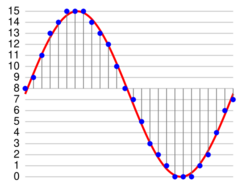G.729.1
| G.729-based embedded variable bit-rate coder: An 8-32 kbit/s scalable wideband coder bitstream interoperable with G.729 | |
 | |
| Status | In force |
|---|---|
| Year started | 2006 |
| Latest version | (03/13) March 2013 |
| Organization | ITU-T |
| Committee | ITU-T Study Group 16 |
| Related standards | G.711, G.729 |
| Domain | audio compression |
| License | Freely available |
| Website | https://www.itu.int/rec/T-REC-G.729.1 |
G.729.1 is an 8-32 kbit/s embedded speech and audio codec providing bitstream interoperability with G.729, G.729 Annex A and G.729 Annex B.[1] Its official name is G.729-based embedded variable bit rate codec: An 8-32 kbit/s scalable wideband coder bitstream interoperable with G.729. It was introduced in 2006.[2]
This codec has been designed to provide better quality and more flexibility than the existing ITU-T G.729 speech coding standard. G.729.1 is scalable in bit rate, acoustic bandwidth and complexity. In addition it offers various encoder and decoder modes, including the support of both 8 and 16 kHz input/output sampling frequency, compatibility with G.729B, and reduced algorithmic delay. The bitstream of G.729.1 is structured into 12 hierarchical layers. The first layer (or core layer) at 8 kbit/s follows the G.729 format. The second layer (adds 4 kbit/s for a total of 12 kbit/s) is a narrowband enhancement layer. The third layer (2 kbit/s for a total of 14 kbit/s) is a bandwidth extension layer. Further layers (in 2 kbit/s steps) are wideband enhancement layers. The G.729.1 output bandwidth is 50–4000 Hz at 8 and 12 kbit/s, and 50–7000 Hz from 14 to 32 kbit/s. G.729.1 is also known as G.729 Annex J and G.729EV where EV stands for Embedded Variable (bit rate).
The G.729.1 algorithm is based on a three-stage coding structure: embedded code-excited linear prediction (CELP) coding of the lower band (50–4000 Hz), parametric coding of the higher band (4000–7000 Hz) by Time-Domain Bandwidth Extension (TDBWE), and enhancement of the full band (50–7000 Hz) by a predictive transform coding technique referred to as time-domain aliasing cancellation (TDAC) or modified discrete cosine transform (MDCT) coding.[2]
As of January 1, 2017, the patent terms of most licensed patents under the G.729 Consortium have expired, the remaining unexpired patents are usable on a royalty-free basis.[3]
See also
References
- ↑ "G.729.1: G.729-based embedded variable bit-rate coder: An 8-32 kbit/s scalable wideband coder bitstream interoperable with G.729". https://www.itu.int/rec/T-REC-G.729.1.
- ↑ 2.0 2.1 Nagireddi, Sivannarayana (2008). VoIP Voice and Fax Signal Processing. John Wiley & Sons. p. 69. ISBN 9780470377864. https://books.google.com/books?id=5AneeZFE71MC&pg=PA69.
- ↑ Sipro Lab Telecom (2017-01-28). "About G.729". http://www.sipro.com/G729.html.
External links
- ITU-T Recommendation G.729.1 - technical specification
- Summary of G.729.1 (05/2006)
- RFC 4749 - RTP Payload Format for the G.729.1 Audio Codec
- RFC 5459 - G.729.1 RTP Payload Format Update: Discontinuous Transmission (DTX) Support
 |

